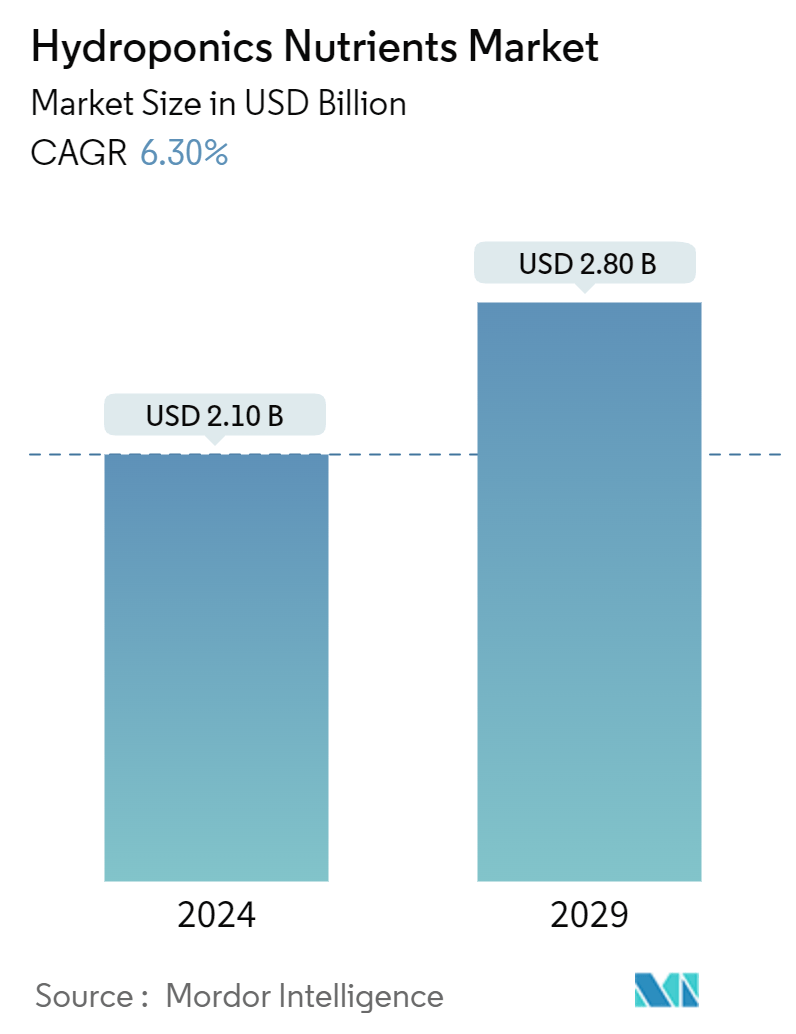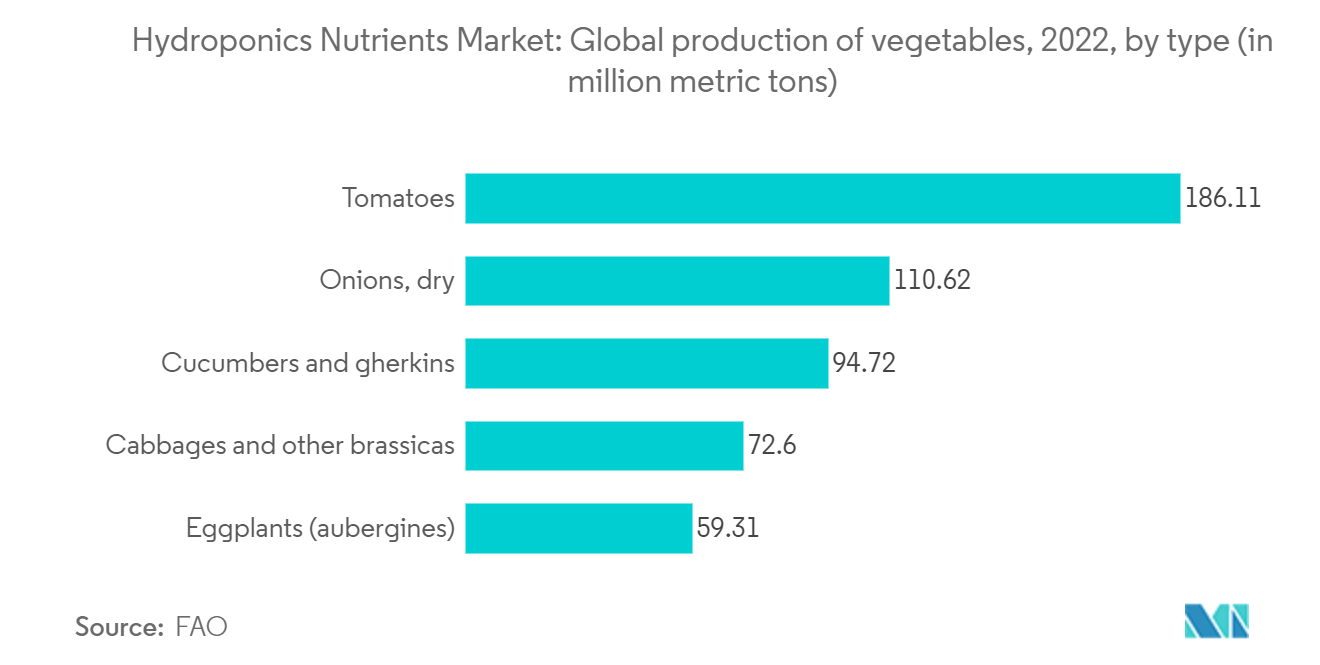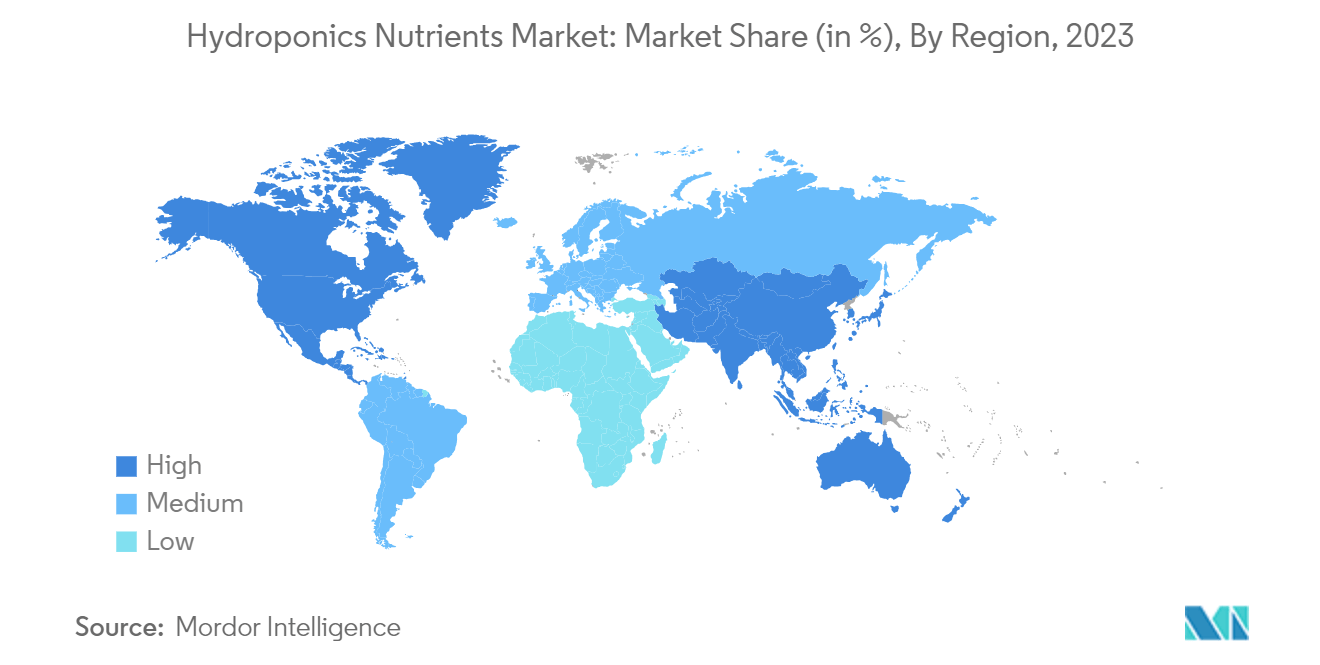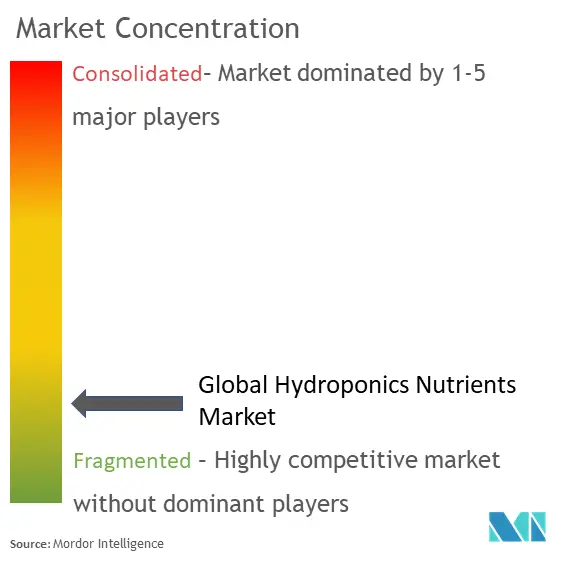Hydroponics Nutrients Market Size

| Study Period | 2019 - 2029 |
| Market Size (2024) | USD 2.10 Billion |
| Market Size (2029) | USD 2.80 Billion |
| CAGR (2024 - 2029) | 6.30 % |
| Fastest Growing Market | Asia Pacific |
| Largest Market | North America |
Major Players.webp)
*Disclaimer: Major Players sorted in no particular order |
Hydroponics Nutrients Market Analysis
The Hydroponics Nutrients Market size is estimated at USD 2.10 billion in 2024, and is expected to reach USD 2.80 billion by 2029, growing at a CAGR of 6.30% during the forecast period (2024-2029).
Global arable land is under increasing pressure, driven by rising nutritional demands and a global shift towards fresh fruits and vegetables. This has led to a surge in hydroponics adoption. Hydroponics not only safeguards the environment but also yields higher crop outputs than traditional open-field methods. Furthermore, heightened health awareness among consumers has spurred demand, accelerating the adoption of hydroponic techniques. In regions where traditional farming faces climatic challenges, hydroponics emerges as a sustainable solution for fresh produce cultivation. With global agricultural land shrinking and crops threatened by pests and natural disasters, production costs are rising. This scenario has fueled global investments in commercial hydroponic systems. Hydroponics stands out as a viable solution for food security, efficiently utilizing space and being accessible even to urban and rural landless individuals. The technology, now standardized for various vegetables, shows promise for herbs and salad crops. Especially in the Middle East and Latin America, where water scarcity and challenging environmental conditions necessitate food and grain imports, hydroponics presents a lucrative opportunity. Concerns over environmental degradation and the greenhouse effect have heightened the significance of hydroponic farming. As agricultural infrastructures evolve, the demand for hydroponics grows, especially to meet the surging vegetable demand. Traditionally, leafy vegetables and microgreens dominated hydroponic cultivation. Yet, there is a rising trend in cultivating warmer-climate exotics like cherry tomatoes and lettuce. North America leads the global hydroponics market, with Asia-Pacific emerging as the fastest-growing region. Countries like Japan, India, and China are pioneering agricultural innovations, with major players in Asia-Pacific ramping up R&D for new hydroponic technologies.
Hydroponics Nutrients Market Trends
Tomatoes Are Widely Cultivated Through Hydroponics
Tomatoes rank among the top crops cultivated globally using hydroponic systems. These hydroponic techniques have demonstrated commercial success in propagating, germinating seeds, and producing tomatoes. By employing this method, growers can cultivate tomatoes in a controlled environment, minimizing disease risks, accelerating growth, and enhancing fruit yield. Recognizing the potential in this niche, domestic tomato producers are rapidly expanding or initiating hydroponic operations across various countries. Given that different growth phases of tomatoes demand distinct nutritional needs, it is essential to tailor nutrient solutions to these developmental stages. This approach not only promotes optimal growth but also fuels the hydroponic nutrient market, further commercializing the overarching market. Medium- and large-scale growers dominate the hydroponic tomato landscape. Looking ahead, market dynamics, including technological advancements and regulatory frameworks, are set to shape the trajectory of the hydroponic tomato market. Rockwool stands out as the predominant medium for hydroponic tomato cultivation. With the rising productivity of tomatoes through hydroponic methods, the market for hydroponics nutrients is poised for growth in the coming years.

North America is The Market Leader
In the United States, the rising demand for greenhouse tomatoes is propelling the market for hydroponic operations. Urban rooftop hydroponic gardens, especially in cities like New York, are further fueling this market expansion. While some greenhouse production is concentrated in traditional tomato-growing states such as California, hydroponics offers a consistent supply. This is particularly advantageous during weather disruptions and monsoon seasons, which often affect traditional vegetable suppliers. High-end cafes and restaurants show a strong demand and enjoy better margins, as they prioritize high-quality vegetables, and consumers are willing to pay a premium. As a result, the surging demand for hydroponically grown vegetables is prompting producers to increasingly favor hydroponic methods over traditional ones.
In Canada, glasshouses predominantly utilize hydroponics for vegetable cultivation. Responding to evolving consumer preferences and concerns about food pricing and availability, greenhouses are emerging nationwide. Canadian hydroponic systems, employing rockwool, perlite, and Nutrient Film Technique (NFT)methods, cultivate tomatoes, cucumbers, and bell peppers. While hydroponics has traditionally focused on specific crops like basil and lettuce, there is potential for a broader range, from kale and quinoa to raspberries and tomatoes. Achieving the right balance of temperature, airflow, water, light, and nutrients is vital, hinting at future innovations. Canadian commercial vegetable producers favor hydroponics due to its efficiency in managing larger production areas and controlling inputs, diseases, and pests. Given that hydroponics can boost yields of popular vegetables and eliminate the need for soil fumigants, a growing number of regional farmers are adopting this method. This increasing adoption is projected to drive market growth.
In Mexico, hydroponic systems predominantly utilize drip irrigation and the NFT. Key hydroponic crops, aligned with growers' profits, include lettuce, tomatoes, peppers, and strawberries. While Rockwool is not widely used across North America, it is a staple for tomato crops in Mexico's drip irrigation systems. Interest in mastering soil-less plant production techniques is on the rise. Compounding challenges like arid conditions and limited groundwater availability—affecting two-thirds of the country's geography—intensify pressure on water resources. Such challenges present a significant opportunity for the vertical farming industry in Mexico. The highest density of hydroponic installations per acre is noted in Mexico's Distrito Federal province. Given the unfavorable conditions for open farming and the growing food security concerns, hydroponic farming in Mexico is poised for growth during the forecast period.

Hydroponics Nutrients Industry Overview
The global hydroponics nutrients market is fragmented. Major players are primarily adopting strategies such as mergers and acquisitions, partnerships, expansions, product launches, and investments in R&D. Through partnerships and collaborations, these players have successfully penetrated new markets and engaged in R&D activities, leading to the launch of products tailored to the needs of growers. Some key players in the market include General Hydroponics, Haifa Group, ICL Group, Nouryon, and SQM.
Hydroponics Nutrients Market Leaders
-
Haifa Group
-
ICL Group
-
Nouryon
-
SQM
-
General Hydroponics
*Disclaimer: Major Players sorted in no particular order

Hydroponics Nutrients Market News
- June 2024: GrowGeneration Corp. announced the launch of its new B2B portal, HRG Marketplace, by its wholesale division, the Horticultural Rep Group (HRG). As a prominent distributor in the hydroponic industry, HRG aims to transform how its customers and partners across the United States access and purchase products. Starting now, the HRG Marketplace is open to over 500 current customers and countless garden centers nationwide, granting them unmatched access to top-tier hydroponic products.
- February 2024: GrowGeneration Corp., the leading chain of specialty hydroponic and organic garden centers in the United States, revealed that Drip Hydro is debuting a new powder nutrient line tailored for cultivation. Drip Hydro, recognized as a frontrunner in agricultural innovation, crafted this powder nutrient line with a keen focus on cannabis cultivation. Setting a benchmark in the market, this state-of-the-art product line stands out as one of the most balanced, pure, and economically viable nutrient solutions currently available.
- December 2022: Freight Farms unveiled its latest hydroponic nutrient line, dubbed Farmhand. This trio, comprising Farmhand form, grow, and boost, is meticulously crafted to deliver vital macro and micronutrients, ensuring robust plant growth in hydroponic setups.
Hydroponics Nutrients Market Report - Table of Contents
1. INTRODUCTION
- 1.1 Study Assumptions and Market Definition
- 1.2 Scope of the Study
2. RESEARCH METHODOLOGY
3. EXECUTIVE SUMMARY
4. MARKET DYNAMICS
- 4.1 Market Overview
-
4.2 Market Drivers
- 4.2.1 Growing Food Security Concerns
- 4.2.2 Demand for Organic Fruits and Vegetables
-
4.3 Market Restraints
- 4.3.1 Less Adoption Rate
- 4.3.2 Limitation on Types of Crops Grown and Technical Expertise
-
4.4 Industry Attractiveness - Porter's Five Force Analysis
- 4.4.1 Threat of New Entrants
- 4.4.2 Bargaining Power of Buyers/Consumers
- 4.4.3 Bargaining Power of Suppliers
- 4.4.4 Threat of Substitute Products
- 4.4.5 Intensity of Competitive Rivalry
5. MARKET SEGMENTATION
-
5.1 Nutrient
- 5.1.1 Nitrogenous
- 5.1.2 Phosphatic
- 5.1.3 Potassic
- 5.1.4 Micronutrients
-
5.2 Type
- 5.2.1 Synthetic
- 5.2.2 Organic
-
5.3 Crop
- 5.3.1 Tomato
- 5.3.2 Cucmber
- 5.3.3 Leafy Greens
- 5.3.4 Pepper
- 5.3.5 Strawberries
- 5.3.6 Other Crops
-
5.4 Geography
- 5.4.1 North America
- 5.4.1.1 United States
- 5.4.1.2 Canada
- 5.4.1.3 Mexico
- 5.4.1.4 Rest of North America
- 5.4.2 Europe
- 5.4.2.1 Germany
- 5.4.2.2 United Kingdom
- 5.4.2.3 France
- 5.4.2.4 Russia
- 5.4.2.5 Spain
- 5.4.2.6 Rest of Europe
- 5.4.3 Asia Pacific
- 5.4.3.1 China
- 5.4.3.2 Japan
- 5.4.3.3 India
- 5.4.3.4 South Korea
- 5.4.3.5 Rest of Asia-Pacific
- 5.4.4 South America
- 5.4.4.1 Brazil
- 5.4.4.2 Argentina
- 5.4.4.3 Rest of South America
- 5.4.5 Africa
- 5.4.5.1 South Africa
- 5.4.5.2 Rest of Africa
6. COMPETITIVE LANDSCAPE
- 6.1 Most Adopted Strategies
- 6.2 Market Share Analysis
-
6.3 Company Profiles
- 6.3.1 General hydroponics
- 6.3.2 Haifa Group
- 6.3.3 Advanced Nutrients Ltd
- 6.3.4 ICL Group
- 6.3.5 Nouryon
- 6.3.6 SQM
- 6.3.7 Am hydro
- 6.3.8 Nutrifield
- 6.3.9 Emerald Harvest
- 6.3.10 WE Hydroponics
- *List Not Exhaustive
7. MARKET OPPORTUNITIES AND FUTURE TRENDS
** Subject To AvailablityHydroponics Nutrients Industry Segmentation
Hydroponics is the method of cultivating plants in mineral nutrient solutions, utilizing mediums like sand, gravel, or liquid, all without the need for soil.
The market is segmented by nutrient into nitrogenous, phosphatic, potassic and micronutrients. By type, the market is segmented into synthetic and organic. By crop, the market is segmented into tomato, cucumber, leafy greens, pepper, strawberries and others. The geographical analysis of the market includes developed and emerging regions, primarily North America, Europe, Asia Pacific, South America, and Africa.
The market sizing has been done in value terms in USD for all the abovementioned segments.
| Nutrient | Nitrogenous | |
| Phosphatic | ||
| Potassic | ||
| Micronutrients | ||
| Type | Synthetic | |
| Organic | ||
| Crop | Tomato | |
| Cucmber | ||
| Leafy Greens | ||
| Pepper | ||
| Strawberries | ||
| Other Crops | ||
| Geography | North America | United States |
| Canada | ||
| Mexico | ||
| Rest of North America | ||
| Geography | Europe | Germany |
| United Kingdom | ||
| France | ||
| Russia | ||
| Spain | ||
| Rest of Europe | ||
| Geography | Asia Pacific | China |
| Japan | ||
| India | ||
| South Korea | ||
| Rest of Asia-Pacific | ||
| Geography | South America | Brazil |
| Argentina | ||
| Rest of South America | ||
| Geography | Africa | South Africa |
| Rest of Africa |
Hydroponics Nutrients Market Research FAQs
How big is the Hydroponics Nutrients Market?
The Hydroponics Nutrients Market size is expected to reach USD 2.10 billion in 2024 and grow at a CAGR of 6.30% to reach USD 2.80 billion by 2029.
What is the current Hydroponics Nutrients Market size?
In 2024, the Hydroponics Nutrients Market size is expected to reach USD 2.10 billion.
Who are the key players in Hydroponics Nutrients Market?
Haifa Group, ICL Group, Nouryon, SQM and General Hydroponics are the major companies operating in the Hydroponics Nutrients Market.
Which is the fastest growing region in Hydroponics Nutrients Market?
Asia Pacific is estimated to grow at the highest CAGR over the forecast period (2024-2029).
Which region has the biggest share in Hydroponics Nutrients Market?
In 2024, the North America accounts for the largest market share in Hydroponics Nutrients Market.
What years does this Hydroponics Nutrients Market cover, and what was the market size in 2023?
In 2023, the Hydroponics Nutrients Market size was estimated at USD 1.97 billion. The report covers the Hydroponics Nutrients Market historical market size for years: 2019, 2020, 2021, 2022 and 2023. The report also forecasts the Hydroponics Nutrients Market size for years: 2024, 2025, 2026, 2027, 2028 and 2029.
Hydroponic Nutrients Industry Report
Statistics for the 2024 Hydroponic Nutrients market share, size and revenue growth rate, created by Mordor Intelligence™ Industry Reports. Hydroponic Nutrients analysis includes a market forecast outlook to 2029 and historical overview. Get a sample of this industry analysis as a free report PDF download.



